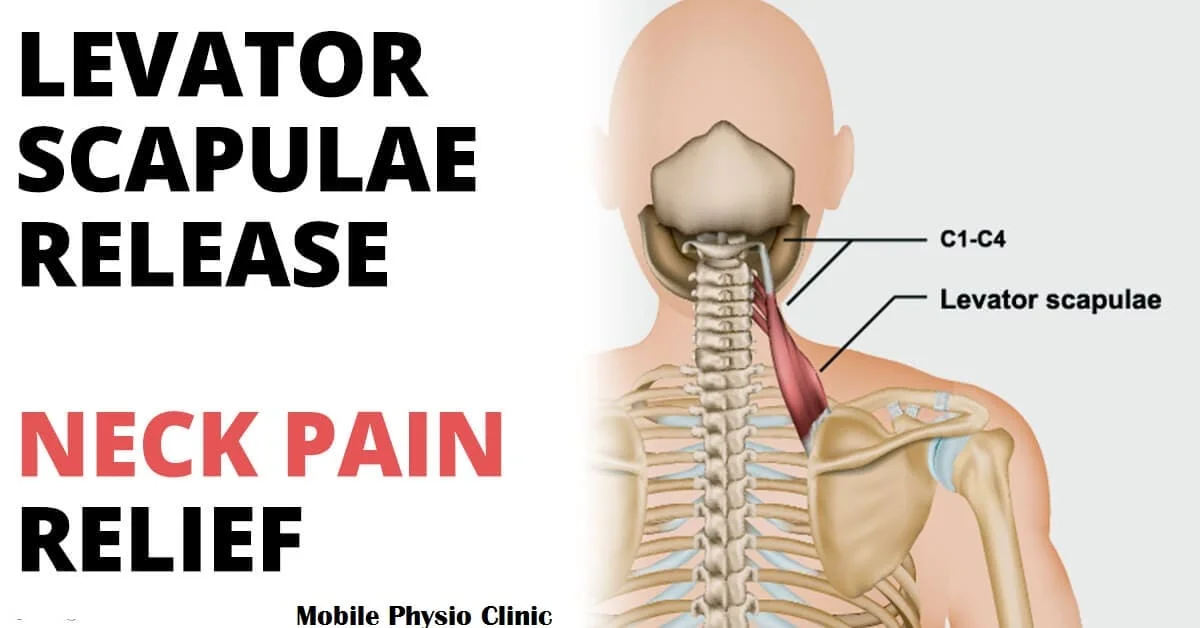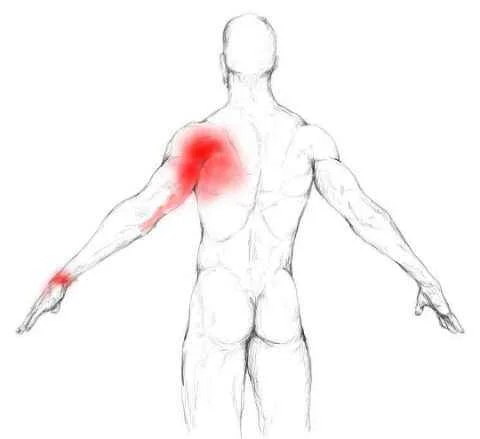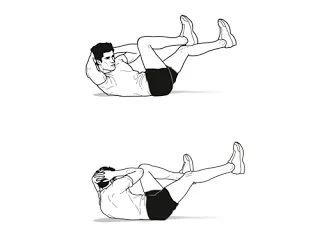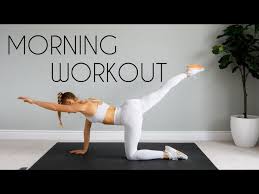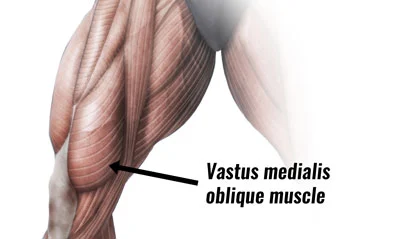Levator Scapulae Syndrome: Physiotherapy Treatment
Levator Scapulae Syndrome is a “pain over the upper medial angle of the scapula” that is still used in clinical practice in certain settings around the world.
This terminology describes a set of signs and symptoms that often present together without identifying the cause of the pain and dysfunction, as is the case with other syndromes such as chronic fatigue syndrome and irritable bowel syndrome. It is considered a better practice to use more specific terminology that refers to relevant causative factors that can be addressed during treatment.
The levator scapulae muscle extends along the back of the neck, with the function of assisting with various neck, arm, and shoulder movements such as shrugging. When the muscle becomes rigid this can cause pain and reduced motion in the area.
Table of Contents
Causes:
- Cervical spine dysfunction.
- Altered shoulder biomechanics or poor posture.
- Repetitive arm motions such as in swimming, throwing, or racquet sports.
- Carrying bags with straps over the shoulder.
- Stress/anxiety: Many individuals who experience the effects of these trigger points also complain of shortness of breath (similar to that associated with panic attacks).
- Working at a computer with the head turned one-sided prolonged time
- Carrying heavy bags with a shoulder strap
- Chilling of the muscle during sleep from a ceiling fan or air conditioner
- Holding a phone between the shoulder and ear for too long
- Sleeping on your stomach with your head turned
- Head forward posture
- Cervical spine dysfunction.
- Repetitive arm motions such as in swimming, throwing, or racquet sports.
- Whiplash injury due to automobile accident
- Sleeping on the stomach with the head turned/or sleeping in an odd position
- Chilling of the muscle during sleep from an air conditioner or draft from an open window
- Working at a computer with the head turned for long periods
- Holding a phone between the shoulder and ear
- Carrying a heavy bag with a shoulder strap
- Use of crutches that are too tall and elevate the shoulder
- Emotional and mental stress
- Working with your arms raised above your head for prolonged periods of time can also irritate the Levator Scapula. To help reduce neck pain, stabilize your shoulder blade when you raise your arm.
- Poor posture with a forward head position puts this muscle under continuous strain causing overuse.
Levator scapulae syndrome is usually caused by poor posture of the shoulders. For example, sitting at a computer hunched over with your shoulders rounded. This posture stretches the levator scapulae muscle and, if performed over a long period of time, it can cause inflammation and pain within the muscle. Poorly designed work furniture may contribute to chronic muscle tension and spasms, plus muscle weakness.
One of the primary functions of the levator scap is to keep your shoulder blade in a position that supports a vertical alignment of your head on your neck, and to prevent forward head posture, a condition in which your head is too far forward.
To understand what a movable shoulder blade may do to your levator scap, which is assigned to keeping it in the right position on your back, imagine standing on a surfboard in the ocean while holding and using your electronic equipment and other office supplies. In this case, dynamic opposing movements would likely require your muscles and bones to both shift independently and to work together to enable you to type, reach for your cell phone, and manage your balance as the water surges underneath you.
When muscles become overstretched, they often become taut as a way of offering stability. This may feel like muscle tension due to muscle shortening, but, it’s actually different than that.
The levator scapula muscle is one of a number of shoulder muscles that may be implicated when you have neck pain. Both the shoulder and neck are very complicated, which means it’s important to get any pain or dysfunction in that area diagnosed by a qualified, licensed health professional.
In athletes and others involved with physical activities, the most prominent cause of levator scapulae syndrome is overuse.
This can arise due to multiple factors. Failure to warm up correctly before activity or to stretch and strengthen the neck muscles regularly is a common contributing factor. Another is to train for extensive periods when the muscles have become noticeably weakened. Similar damage can be caused due to greatly increasing your exercise program very quickly, as this does not allow the muscles sufficient time to adjust. Outside of sports, the syndrome can be caused by maintaining bad posture, usually as a result of sitting for long periods such as in a desk job. Prior injury to the shoulders or neck, or any pre-existing deficiency in those areas, can also put you at higher risk.
Levator scapulae syndrome symptoms:
The main symptom is that of pain which is felt in the upper back, where the muscle attaches to the top of the shoulder blade. Pain can also be felt in the neck, over the top of the shoulder, or between the shoulder blades. This pain may disappear quickly when heat is applied over the shoulder blade. Other symptoms include:
- reduced range of movement of the Neck
- swelling/inflammation
- Neck stiffness
- weakness of muscles
- numbness
- Muscle spasm
If you have or suspect you have levator scapulae syndrome, you should arrange an appointment with your physiotherapist.Sharp pain in and around the neck, often radiating upwards and leading to headaches. The neck area may also become noticeably inflamed. It is not unusual to experience a prolonged feeling of discomfort in the area. Movement can be restricted in the neck and shoulders, with pain and stiffness worsening when attempting many everyday motions. The syndrome most frequently affects the left side of the body.
Neck pain, which may extend to the head causing a headache.
Pain and restricted range of movement especially reduced cervical flexion and side flexion to the contralateral side.
Deep, achy pain and/or tightness on the upper back along the top of the shoulder blade or neck.
Increased muscle tone and trigger points. Active trigger points are more frequent in patients presenting with mechanical neck pain.
Trigger point:
The Levator Scapulae can present with two trigger points located in the lower half of the muscle. The lower trigger point lies just above the superior angle of the scapula and the upper trigger point lies 1-3 inches above the lower trigger point. Both trigger points lie deep to the upper trapezius muscle and both refer pain laterally to the shoulder and along the medial aspect of the shoulder blade.
Trigger points in the Levator Scapulae are also commonly misdiagnosed as cervical joint dysfunction so careful cervical assessment is required for individuals that present with these symptoms.
With this presentation of pain and trigger points in the region of the levator scapulae, it is important to complete a full assessment of the cervical spine as pain in this region is often referred from the cervical spine.
The presenting pain is likely to be reproduced on active and passive range of movement testing of the cervical spine especially flexion and side flexion to the contralateral side (placing the muscle in a lengthened position). The muscle is also likely to be tender on palpation and may present with increased tone, especially in the region and referral pattern of the trigger points.
You must also rule out the thoracic spine and shoulder. The phenomenon of levator scapulae pain of cervical origin being reproduced on shoulder movement has long been clinically recognized.
Physiotherapy treatment
Physiotherapy is very important in the treatment of levator scapulae syndrome. Initially, they can diagnose your problem and explain the reason why you developed the syndrome.
After Diagnosis, your physiotherapist will be able to plan an appropriate treatment plan to reduce your pain and reduce the chance of it returning. This may involve:
- Pain relieving Electrotherapy modalities eg. Interferential Therapy, TENS, and Ultrasound Therapy to reduce Pain Spasm, Tenderness
- Manipulation / Mobilisation
- Exercise Programmes
- Massage
- Ergonomic Assessment
- Postural Realignment
- Soft Tissue Treatment
If you have or suspect you have levator scapulae syndrome, you shouldn’t ignore the problem. Your pain may improve if you apply heat over the shoulder or massage the sore area; however, unless the cause of the problem is identified and addressed the pain will continue to return and get progressively worse.
Levator scapulae syndrome does not produce any long-term effects if it is accurately diagnosed and appropriately treated. Primary treatment will be aimed at the dysfunction that you hypothesize to be causing the levator scapulae dysfunction i.e. the cervical spine. It is also important that biomechanical problems that may be contributing to the condition, such as neck or shoulder muscle imbalances, postural problems, or thoracic mobility are identified and corrected as these are usually the cause of increased demand on the levator scapulae.
Treatment options include postural advice to ease the demand on the levator scapulae as well as stretching exercises to relieve tension. The levator scapulae can respond well to Active Release Techniques (ART).
Osteopathy:
Adjustments can be performed anterior to posterior or lateral to medial, depending on the position of the injured muscle.
Stretching: Oftentimes, a levator scapulae stretch can be helpful along with some of the other treatment approaches, such as massage.
Posture adjustments: Learning proper sitting positions if the problem was caused by poor posture can make a big difference. When sitting, make sure your upper back and neck are not hunched over.
Over-the-counter medications: There are some over-the-counter pain relievers that can help control pain
Stretching the Levator Scapulae and the surrounding muscles like the trapezius (upper and lower) are beneficial in reducing the pain, and increasing the range of motion and quality of life.
The levator scapulae is a muscle that’s located at both sides of the back of the neck. This muscle functions to raise or elevate the scapula, shoulder blade, such as when you shrug your shoulders. Levator scapulae syndrome is a condition in which the levator scapulae muscle becomes irritated and inflamed. The main cause of levator scapulae syndrome is sitting for long periods at a time, particularly when you sit with poor posture. Sitting for a long stretch of time with poor posture puts a lot of stress and pressure on the various muscles in the neck and back, including the levator scapulae muscle. Over time, this constant stress and pressure can irritate the levator scapulae, inflaming it and causing it to become sore.
Additionally, physical trauma can cause levator scapulae syndrome. Sports collisions, falls, and car accidents can all cause this condition. For example, whiplash during a car accident can damage the muscle, leading to levator scapulae syndrome. Additionally, a football player might get tackled during a game and land awkwardly on his head and neck, causing the levator scapulae muscle to become damaged and eventually resulting in levator scapulae syndrome.
Physical therapy may help you reduce the degree of stress that is placed on the levator. Stretching, strengthening, and posture lessons may also help reduce pain, increase the physical functioning of the upper body and, in general, improve your quality of life.
Scapulothoracic Articulation The scapulothoracic articulation is an intricate, sliding, junction that composes part of the shoulder in conjunction with the glenohumeral, acromioclavicular, and coracoclavicular joints. The scapula has a complex anatomical relationship, comprised of 17 muscular attachments, that function to dynamically stabilize the scapula and control the position of the glenoid to permit a wide range of motion for the upper extremity through the glenohumeral joint. The scapula does not have any ligamentous connections to the thorax. Due to the complexity of the scapulothoracic articulation, scapulothoracic disorders can present and go underdiagnosed or underestimated because of the various, and often subtle, morphological alterations in normal architecture.
Treatment:
Interferential Therapy (IFT):
Current is applied to the levator scapula muscle of medium frequency to tire and sedate the muscle causing a relaxing effect on it.
Massage
Therapists perform a myofascial massage to soften and break adhesions caused in the muscles. The maneuvers are aimed at elongating the levator scapulae in order to achieve complete relaxation.
Ultrasound Therapy
Pulsed ultrasound is performed using a sedative anti-inflammatory gel which is applied to the injured levator scapula.
Chiropractic
Chiropractic adjustments are performed anterior to posterior, lateral to medial, or a combination of both and vice-versa, depending on the position (right or left) of the injured muscle. (this must be done by a certified Chiropractor)
Exercise:
1)Standing Levator Scapula stretch:
This is the most effective exercise for the Levator Scapula strain. To perform the exercise, stand up straight with feet placed shoulder wide. Now, bend your chin to touch your chest with a slight deflection towards your right. Place your right hand on your head and pull down gently. You will feel a good stretch on the left side of your neck. Hold for 10 seconds and return to the neutral position. Repeat 3-5 times and then switch sides.
2)Head Rolls
Head rolls have to be performed in two ways, 1) side to side from left to right and 2) in a circular motion, clockwise as well as counterclockwise.
3)Feline stretch
To perform this exercise you will have to kneel down on all fours with your hands and knees in a relaxed position. Now, raise your back upwards like a cat, hold it for 5 seconds, and return to the neutral position. Repeat 5 times in 3 sets
Exercise 1
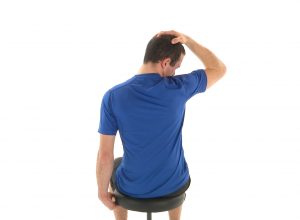
Sit tall on a straight chair.

Grab the bottom of the seat with your hand on the injured side to lower the shoulder by pulling down.
Tilt and turn your head to the opposite side.
Nod head forward until a stretch is felt along the side and back of the neck.
Apply extra pressure (gently) with your hand to increase the stretch if needed.
Hold the stretch and relax.
Exercise 2
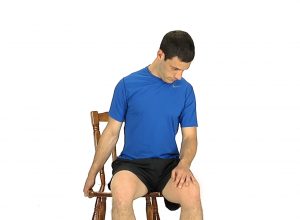
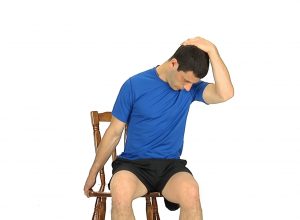
Sitting on a bench or chair on the side edge, hold under the bench with the hand on the tight side, ensuring that the arm is out from the body and that the shoulder is down.
Drop your head forward onto your chest.
Side bend and rotate the neck away from the tight side, bringing your chin towards the opposite armpit.
Bring your opposite hand up onto the side of your head to assist the stretch.
Return to the starting position and repeat.
Exercise 3
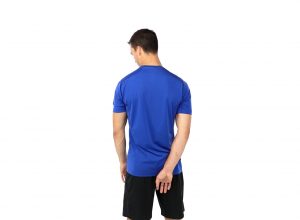
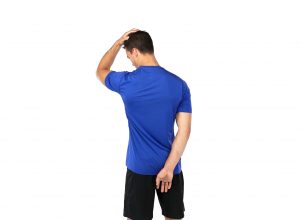
Place one hand behind your buttock to lower your shoulder.
Turn your head to the opposite side and look down.
Gently pull down on your head with the other hand and maintain the position when you feel a stretching sensation. Repeat.
Exercise 4
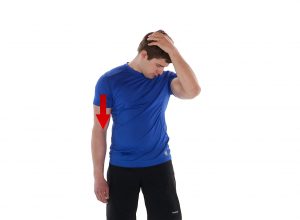
You can do the stretch seated or standing.
Keeping the shoulder down on the side that you are stretching, look down and toward the opposite hip until you feel a comfortable stretch in the back of your neck.
Hold for the recommended time then relax.
You can sit on your hand on the side you are stretching to pull the shoulder down even more.
Use your opposite arm to pull your head down into a deeper stretch.
Exercise 5


Step on a strong band on the same side as the side to stretch.
Grab the band with the hand, allowing the band to anchor your arm and shoulder down.
Side-bend your head toward the opposite shoulder of the anchoring side. Next, tuck your chin toward the opposite side to look at your front pocket.
You should feel a comfortable stretch on the side of your neck and above your shoulder blade on the same side as the band.
Hold the position and repeat the exercise on the other side by stepping on the band with the opposite foot.
Exercise 6
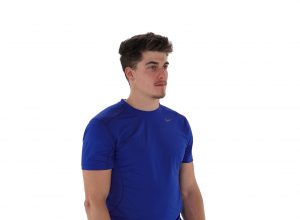
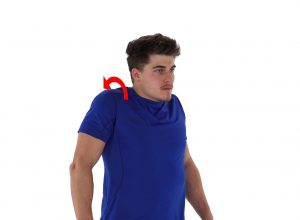
Stand with your arms relaxed on each side of your body.
Make backward circles with your shoulders.
Exercise 7
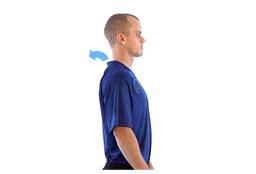
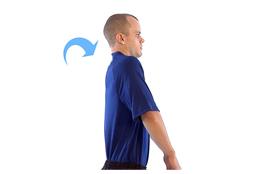
Stand with your arms relaxed on each side of your body.
Make forward circles with your shoulders.
Relax and repeat.
Exercise 8
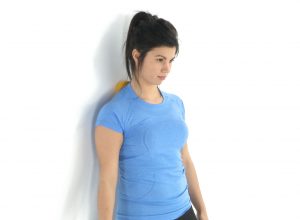
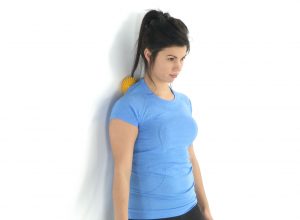
Stand against a wall with a spikey ball placed on your upper back above your scapula (on the levator scapulae muscle).
Apply a comfortable pressure (“feel good” pain).
Keep the pressure, and move your body up and down to slowly roll the ball along the muscle.
You can pause on the tighter spots for up to 30 seconds.
You can vary the direction of the rolling and switch for a more horizontal style if you want to.
Stretching Exercise:
1)Sit up straight with both hands at the sides.
2)Raise the right arm forward and reach over the back with the hand grasping the right shoulder blade and applying downward pressure. (This step rotates the shoulder blade downward, which helps lengthen the levator scapulae muscle even more before it is stretched. If raising the elbow above the shoulder is too complicated at first, this step can be skipped.)
3)While keeping everything else still, rotate the head to the left about 45 degrees (which is about halfway toward the shoulder).
4)Tilt the chin downward until a good stretch is felt on the back right side of the neck.
5)To increase the stretch further, the left hand can be brought up to the back of the head to gently pull down a little more.
6)Hold for 30 to 60 seconds, or as tolerated.
7)Repeat on other side.
Posture Correction:
Posture is key to a healthy neck and spine. Try and sit up straight on a comfortable supportive chair, when at work or at home. Allow your shoulders to relax by using the armrests of the chair. When at a computer, pull the screen close and try to get the screen up at eye level (say using books underneath it). This will mean your head won’t have to be protruding forward. The same applies when driving a car. Pull the seat in close to the steering wheel(within reason). Try to position yourself so the shoulders are relaxed and the head isn’t jutting forward. Activities like reading in bed, playing computer games for hours, etc. can really tighten up the levator muscles. They are a disaster for thoracic and cervical posture in the long term.
Usually, the condition settles after a few days if it is only a once-off. Proper hands-on deep tissue massage and dry needling, when used together, can be great to settle the condition either in the short term, or if the condition has become more chronic. Also in the long term, correcting posture, stretching,g and strengthening of the upper back(particularly middle / lower traps, serratus posterior, rhomboid, etc.) and the neck muscles(specifically the posterior neck muscles) can help prevent the condition from returning.
Rehabilitation:
As long as there are no complications and you rest appropriately, the injury should soon begin to clear up. When you are pain-free, you will be able to commence physical therapy with the doctor’s approval. This stage is important for gradually replacing the lost strength in the neck and building up flexibility in the area before attempting to return to activity. Your doctor or a physiotherapist can assist with recommending suitable neck and shoulder exercises, while massage can also be helpful.

